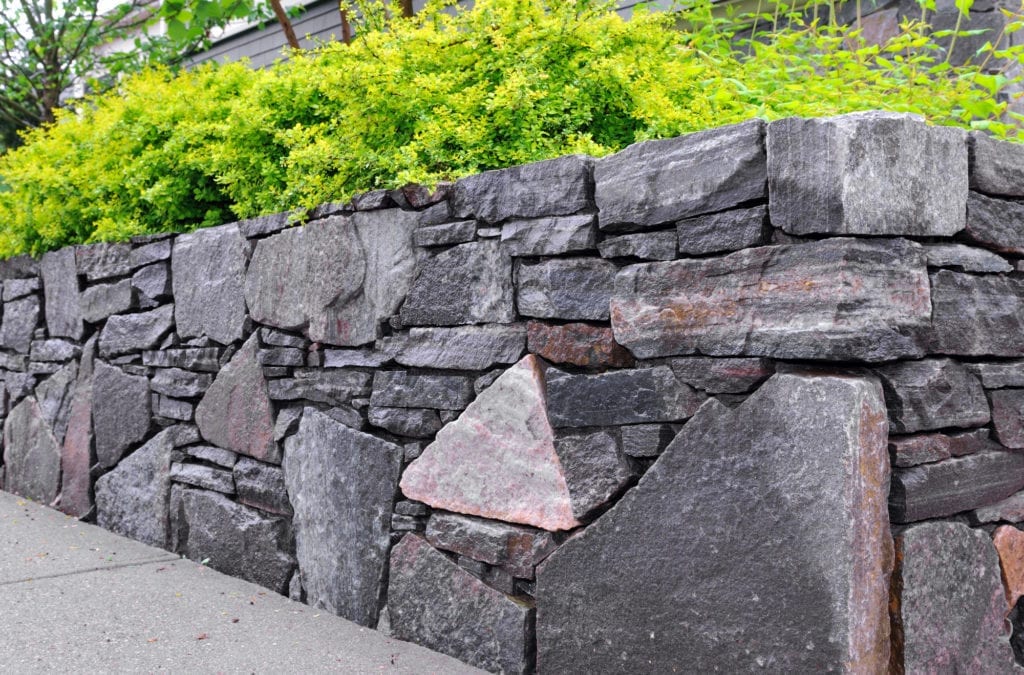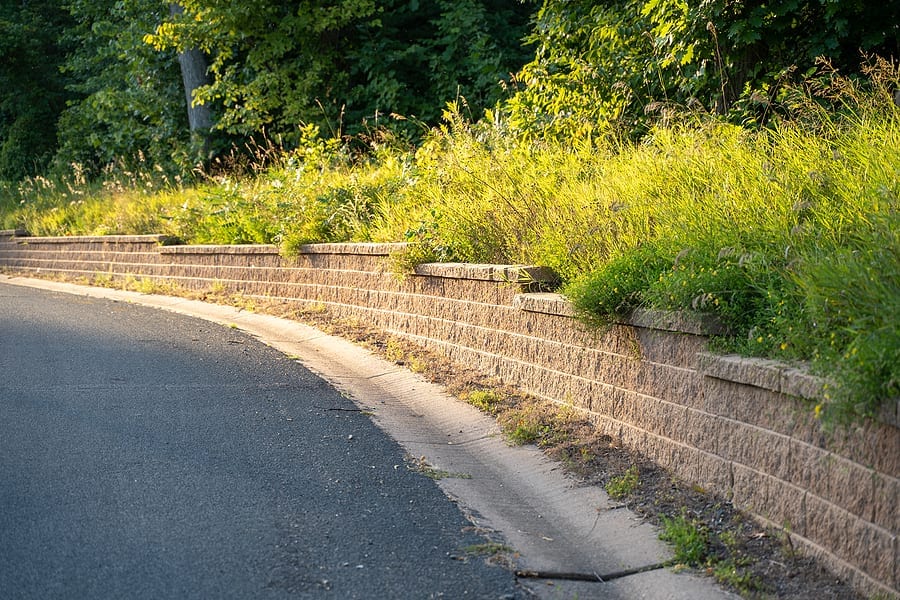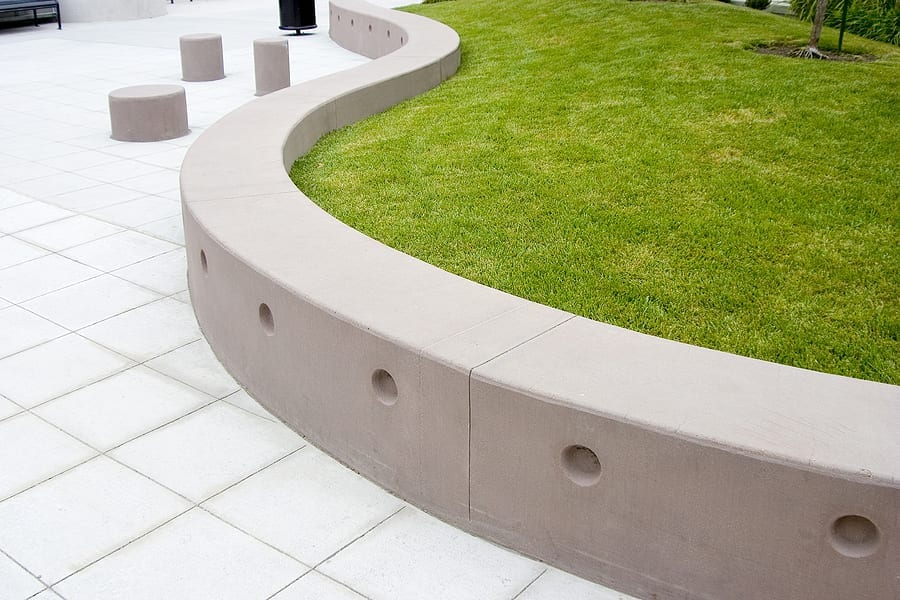How Much Does a Retaining Wall Cost?
The national average cost for a retaining wall is around $25 – $50 per square foot. Here’s how to calculate the cost for your retaining wall project. In the US, the total average cost will run approximately $5,800.
Retaining Wall Solutions |
Cost |
|---|---|
| Full Concrete Demolition | $5 per square foot |
| Leveling & Grading | $1.31 per square foot |
| Heavy Equipment | $175 |
| Materials (see below for breakdown) . | $5-$32 / sq. ft. |
| Labor Fees | $55 per hour |
| Designs and Architectural Service | $80 per hour |
| Water Drainage System | $67 per linear foot |
Fill out the form to compare prices and estimates from local concrete companies.
Building a retaining wall on a sloping property can have several benefits for property owners, as follows:
- Preventing landslides
- Stabilizing hillside properties
- Yard expansion
- Keeping water at bay on lakefront properties
Due to these benefits, a retaining wall can add value and aesthetic appeal to your home as well as increase the enjoyment you get out of your yard.
Retaining Wall Length x Depth |
Estimated Cost |
|---|---|
| 10 x 3-feet (30 sq.ft.) | $1,650 |
| 20 x 3-feet (45 sq.ft.) | $2,900 |
| 25 x 3-feet (75 sq.ft.) | $3,800 |
| 30 x 4-feet (100 sq.ft.) | $6,224 |
| 50 x 4-feet (160 sq.ft.) | $9,000 |
| 60 x 4-feet (240 sq.ft.) | $12,000+ |
According to the NAR’s latest Remodeling Impact Report for outdoor features, hardscaping upgrades like retaining walls, are among the top four features that add appeal and value to a home.
If you’re considering installing a retaining wall, your first question is likely, ‘How much does a retaining wall cost?’
What Is a Retaining Wall?
A retaining wall is any structure that holds soil in place behind it.

As such, they’re instrumental in preventing a landslide from destroying property and endangering lives.
They’re used for a wide range of applications both large and small. These include:
- Enormous soil-retaining projects alongside highways
- To help control erosion from hard rains
- Create an attractive terraced yard
- To create focal points in a garden
- To level a slope
- Creating attractive outdoor entertainment areas
When planning a retaining wall, its important to consider the use of the structure during the planning phase. This will affect every aspect of your build.
Other things to bear in mind are:
Location
Know your limits when building a retaining wall. You should check on aspects like irrigation, local regulations, your property boundaries, and stormwater management protocols.
You should also consider the slope of your environment and what to do with any excess soil you remove.

Be cognizant of natural drainage patterns that could have an environmental impact downstream.
It’s also important to build a wall that’s strong enough to endure any extra load you’ll place on it, like fencing or a paved driveway.
Soil Type
Is the soil at the base of your wall strong enough to support it?
The base of your wall should be firm and solid, without excess moisture. Clay soils are already saturated with water, and unable to support the weight of a retaining wall.
Sandy soils are best for drainage.
A geotechnical report will reveal the presence of problem soils, groundwater conditions, and the chemical properties of your soil.
Design
The final aesthetic appeal’s an important part of the design process but you should also consider the following:
- Setback angle
- Footprint size
- Gravity
Gravity will cause the retained soil to move downslope, so it’s important to counteract these effects in your design. This force increases according to how steep your hill is.
Excessive gravitational forces can cause your wall to collapse.
All these aspects will affect the type of wall you choose to build as well as the materials you use.
Types of Retaining Walls
Fortunately, there are retaining wall systems available to suit almost all of the above conditions. So, once you’ve got a clear idea about the properties of your landscape, you can decide on the type of retaining wall that best suits your needs.

There are three main types of retaining walls to choose from:
Gravity Walls
Gravity retaining walls depend on their weight and setback to retain the soil. They’re usually short walls under 4-feet high, so they’re cheaper to build.
Gravity walls are self-supporting up to 10-feet, although you’ll need a permit to build one higher than 4-feet.
Gravity walls can have a straight or curved shape. They’re made from heavy materials like concrete blocks, cast-in-place concrete, or stone.
Block retaining walls work well in these settings as they automatically form a setback that helps support the pressure of the soil behind the wall.
Segmental Retaining Walls
Segmental retaining walls are a type of reinforced gravity wall that works well for both residential and commercial sites. They’re especially good for high-sloped terrain and usually have no height restrictions.
You can design them according to any shape as they’re made from interlocking modular blocks.
Reinforced Retaining Walls
Reinforced retaining walls use some type of reinforcement to add strength to the retaining wall structure and better retain the soils behind it.
Usually, contractors place Geogrid made of polymers in between courses of blocks and roll it back into the slope to help retain the soil. This makes the soil mass stronger and more stable.
This mesh works with the blocks to create a stronger, heavier wall structure. In cases where geogrid won’t work, no-fines concrete, soil nails, or earth anchors will suffice.
The latter types of reinforcement are usually designed by an engineer.
Cantilevered Walls
Cantilevered retaining walls rely on leverage to work and are best suited for tall walls up to 18-feet with deep excavations.
They usually have an inverted T-shape made from mortared masonry or reinforced concrete. The wall has a base slab made from rigid concrete and divided into two parts –
- The heel which goes under the backfill
- The toe which makes up the other part
A relatively thin stem is then fixed in place on top of that. Often, concrete contractors can pour a cantilevered wall onsite.
Counterfort Walls
These are a type of cantilevered wall that has additional supports in the form of concrete webs placed at an angle along the back of the wall. These webs, called counterforts, help reduce soil pressure along the wall while increasing its weight and strength.

These types of walls are best for very tall structures over 25-feet.
Panel Walls
Panel walls are the type of retaining walls used in highway ramps. These walls use steel posts to connect a series of precast steel-reinforced panels to contain the soil.
Most panel walls are custom designed and used for very large projects.
Gabion Mesh Walls
Gabion mess walls are most often used along streams to prevent erosion. They consist of rectangular wire mesh baskets filled with rocks.
The next step is to stack the ‘bricks’, angle them back against the slope, and tie them together. Gabion mesh walls only last as long as it takes for the metal basket to corrode.
Types of Materials Used for Retaining Walls and The Cost
You can get most types of retaining walls in colors or textures to suit your design. Yet, the most important part of retaining wall construction is the materials they’re made from.
Treated timber is a simple and inexpensive choice for retaining walls but it has a noticeably short lifespan.
Retaining Wall Material Type |
Estimated Cost Per Square Foot |
|---|---|
| Cinder Blocks | $13 per sq. ft. |
| Poured Concrete | $23 per sq. ft. |
| Wood Timber | $20 per sq. ft. |
| Stone Veneer | $13 per sq. ft. |
| Boulder/Rock | $11 per sq. ft. |
| Gabion | $6-$35 per sq. ft. |
| Brick | $14 per sq. ft. |
| Corten Steel/Metal | $4 per sq. ft. |
| Earth/Chalk | $5-$20 per sq. ft. |
Stones, boulders, and rocks are a durable and attractive choice, but it’s expensive and time-consuming to install them. They’re also a haven for rodents and weeds and need ongoing maintenance to look their best.
Brick retaining walls offer excellent strength and durability but they’re also expensive and labor-intensive.
Cast-in-place and mortared retaining walls are an excellent choice for most retaining walls. They’re strong and durable, as well as capable of withstanding most climates and weather events.
They’re flexible concerning textures, veneers, and colors too.
Factors That Affect the Cost of Retaining Walls
The cost of retaining walls can vary widely depending on several factors. In this article, we will explore some of the critical factors that affect the cost of retaining walls.
- Retaining Wall Height: One of the most significant factors affecting the cost of retaining walls is the height of the wall. The taller the wall, the more materials will be required to build it, resulting in higher costs. Additionally, taller walls often require specialized engineering and installation techniques, which can further increase the cost.
- Wall Length: The length of the retaining wall is another crucial factor that can impact the overall cost. Longer walls require more materials, which can result in a higher cost. Additionally, longer walls may require additional drainage systems to prevent water from accumulating behind the wall, which can add to the cost.
- Type of Material: The material used to build the retaining wall can also have a significant impact on the cost. Common materials for retaining walls include concrete, stone, brick, and timber. The cost of each material can vary depending on the quality, availability, and complexity of installation. For example, natural stone is generally more expensive than concrete, but it can provide a more aesthetically pleasing result.
- Site Accessibility: The accessibility of the site where the retaining wall is being built can also impact the cost. If the site is challenging to access, it may require specialized equipment or additional labor, which can drive up the cost. Additionally, if the site has limited space for equipment or material storage, it may require more trips to the site, which can increase the cost.
- Soil Conditions: The type and condition of the soil where the retaining wall will be built can also impact the cost. Soft or unstable soil may require additional reinforcement, such as geogrid or geotextile, to provide the necessary support, which can increase the cost. Additionally, soil conditions can affect the drainage requirements of the retaining wall, which can also impact the cost.
Retaining walls can be a valuable addition to many landscaping and construction projects. However, the cost of building a retaining wall can vary widely depending on several factors, including the height and length of the wall, the type of material used, site accessibility, and soil conditions. By understanding these factors, you can make informed decisions about the design and construction of your retaining wall to ensure it meets your needs and budget.
How Much Does a Retaining Wall Cost per Square Foot?
Contractors price most retaining walls by the square foot for materials and labor. All the factors mentioned above will determine the retaining walls cost per square foot.

If you want to build a retaining wall that’s higher than 4-feet, you need a structural engineer to assist with the job. This will increase your costs considerably.
That’s why it’s important to get as many quotes as you can before you hire a contractor to start work on your retaining wall and landscaping. You don’t want to get halfway through the job and have to put everything on hold because you can’t afford to carry on.
The national average cost for a retaining wall is around $25 – $50 per square foot. Here’s the typical cost by the type of retaining wall you need:
Type of Retaining Wall Installed |
Estimated Cost Per Square Foot |
|---|---|
| Sheet piling | $15 per square foot |
| Gravity | $19 per square foot |
| Anchored | $23 per square foot |
| Hybrid | $21 per square foot |
| Cantilevered | $22 per square foot |
| Counterfort | $20 per square foot |
| Reinforced | $21-$27 per square foot |
| Rammed earth | $19-$25 per square foot |
| Criblock | $26-$33 per square foot |
It’s difficult to know what size retaining wall you’ll need offhand, but you can calculate the approximate size using the formula below:
- Using a tape measure, measure the length in feet of the area where you want to place your wall
- Measure the desired height of the wall
- Add .5 to the measurement to compensate for the footers that sit underground
- Multiply these two measurements together to determine the total square footage of the wall
- If you want to know how many square inches you’re working with, multiply this figure by 144
It’s always best to round your calculations up when you’re looking for retaining wall prices online. This ensures you don’t underestimate the cost of a retaining wall.
How Much Does a Lake Retaining Wall Cost?
If you live near a lake or other body of water, your home could be at risk from flooding in times of heavy rain.
All water bodies rise during these times and a lake retaining wall could protect your home and garden from serious damage.
Rocks and stones can serve as an effective barrier against high-water levels. You can also build a retaining wall from any material that suits the design of your home.
It’s important to consider environmental issues, like beach access for aquatic species. In areas where turtles occur, choose a material like stones so these creatures can still climb up onto the shore when needed.
Usually, a lake retaining wall’s set back from the water’s edge at an acceptable distance from your home. In these cases, you can calculate the cost per square foot as above.
If you decide to build a retaining wall in the water, your costs will escalate considerably. You’ll need to negotiate a bevy of expert environmental consultations as well as pay for excavation costs to install the wall.
The Hidden Costs of Retaining Walls: Maintenance and Repair Expenses
Retaining walls are structures that are designed to hold back soil and prevent erosion. They are often used in landscaping projects to create terraced gardens or to provide support for buildings on sloping terrain. While retaining walls can add aesthetic appeal and functionality to a property, they also come with hidden costs that many people may not consider. In this article, we will discuss the maintenance and repair expenses associated with retaining walls.
- Regular maintenance is required to keep retaining walls in good condition. Depending on the materials used to construct the wall, maintenance may include cleaning, repairing cracks or damage, and checking the drainage system to ensure proper water flow. Neglecting maintenance can lead to more significant problems and higher repair costs in the long run.
- Repair expenses can quickly add up if a retaining wall fails. A wall that is not structurally sound can collapse, causing damage to surrounding property, potential injury to people, and legal liabilities. Repairs may involve removing and replacing portions of the wall, rebuilding the entire structure, or even excavation and grading work to stabilize the land behind the wall.
- Soil erosion can occur behind retaining walls, which can lead to shifting and settlement of the wall. This can cause cracking and damage to the wall, which may require repair or replacement. Additionally, the settlement can cause changes in the slope of the land, affecting the overall drainage of the area.
- The cost of materials used to construct retaining walls can vary significantly depending on the type of wall, the height, and the materials used. More complex designs and materials may result in higher construction costs upfront, and also require more maintenance over time. The total cost of the wall should include maintenance, repair, and replacement expenses, not just the initial construction cost.
- The location of the wall can also impact costs. Walls located in areas with high traffic or exposure to the elements may require more frequent maintenance and repair than those in more protected areas. Additionally, the accessibility of the wall can affect the cost of repairs, as difficult-to-reach areas may require more specialized equipment and labor.
In summary, retaining walls can add value to a property, but it is essential to consider the hidden costs associated with maintenance and repair. Proper maintenance and inspection can help prevent expensive repairs, and early repair can save significant costs down the road. It is crucial to work with an experienced and reputable contractor to ensure the wall is designed and constructed correctly and to manage maintenance and repairs effectively.
How Long Will a Retaining Wall Last?
A well-built retaining wall can last between 50 and 100 years. However, some things can affect how long it lasts. The longevity of your wall depends on two major factors:
Materials
The more durable materials like concrete and stone will last longer. A brick wall has the longest lifespan of all. Choosing a knowledgeable contractor’s the best way to ensure your wall lasts as long as possible.
Climate
Consistent severe storms will wear your wall out faster. Likewise, temperatures that fluctuate between extremes can cause cracks in concrete over time. It’s important to inspect your wall regularly for maintenance issues.
Considering the high cost of retaining walls, you want them to last as long as possible. One of the best ways to ensure your wall lasts a long time is to get an experienced contractor’s advice on how to make it last longer.
There are a few things you can do to get the maximum lifespan out of your retaining wall, too. These are:
- Check your retaining wall regularly
- Repair any cracks and signs of damage promptly
- Remove debris from drainage pipes
- Replant any dead spots
If your wall starts to bulge, you could be in for serious problems. Get professional help right away.
How Much Does It Cost to Repair a Retaining Wall?
Act swiftly when your retaining wall needs repairs.
Most retaining walls will need some sort of repair over their lifetime. This could be due to poor initial construction, age, or severe water saturation.
According to estimates, you could spend between $200 and $800 on each repair.
If you build a wall out of interlocking stones, you can reduce the number of repairs your wall’s likely to need overall. These pieces fit together like building blocks and your contractor will hammer them down to ensure a snug fit.
Since there are fewer elements involved in this type of construction, fewer things can go wrong.
Take the Next Step Toward Building a Retaining Wall
The cost of a retaining wall and other home repairs can vary considerably according to your location.
For example, Hawaii has the highest construction-related labor costs in the USA. Oklahoma’s known for its cheap labor and building costs.
So, how much does a retaining wall cost in your area? The easiest and best way to find out is by getting up to 5 quotes and comparing them right here on our website.
Click below to get your quotes or keep reading our blog for more information on how to keep your home in good repair as well as increase its value and appeal.

DIY vs. Hiring a Professional: Which Is More Cost-Effective for Your Retaining Wall Project?
Retaining walls can be a great addition to any property, offering both functionality and aesthetic appeal. But when it comes to building one, the question of whether to DIY or hire a professional arises. While there are advantages and disadvantages to both options, the ultimate decision comes down to which is more cost-effective for your specific project.
DIY Retaining Wall
Pros:
- Cost Savings: The most significant advantage of DIY is cost savings. By taking on the project yourself, you can avoid the labor costs associated with hiring a professional contractor.
- Customization: Another advantage of DIY is the ability to customize the design and materials used. You can choose the exact size, shape, and color of the materials to suit your tastes and preferences.
- Personal Satisfaction: Building something with your own hands can be a gratifying experience, providing a sense of personal satisfaction that can last long after the project is complete.
Cons:
- Skill and Experience: Building a retaining wall requires skill and experience, particularly for larger and more complex projects. If you lack the necessary skills and experience, the project may end up costing more than it would have to hire a professional contractor.
- Time and Effort: DIY projects can be time-consuming, particularly if you are working alone. You may have to sacrifice weekends or evenings to complete the project, which can be stressful and impact other areas of your life.
- Safety Concerns: Retaining walls can be dangerous if not built correctly. If you don’t have the necessary safety equipment and knowledge, you could risk injury or even death.
Hiring a Professional
Pros:
- Expertise and Experience: A professional contractor has the necessary expertise and experience to build a high-quality retaining wall that meets all safety standards and regulations.
- Time Savings: Hiring a professional can save you time, allowing you to focus on other areas of your life while the project is being completed.
- Quality Workmanship: A professional contractor will have access to high-quality materials and tools, ensuring that the retaining wall is built to last.
Cons:
- Higher Cost: Hiring a professional contractor will likely cost more than a DIY project. This can be a significant disadvantage, particularly for those on a tight budget.
- Limited Customization: While you can still provide input on the design of the retaining wall, a professional contractor will have their own design and style preferences.
- Dependence on the Contractor: When hiring a professional contractor, you become dependent on their schedule and availability. Delays in their availability can result in project completion taking longer than expected.
Conclusion: Deciding between a DIY project and hiring a professional contractor for your retaining wall project comes down to cost-effectiveness. While DIY projects can save you money, they may not be the most cost-effective option if you lack the necessary skills and experience. Hiring a professional may be more expensive, but it can save you time and provide peace of mind, knowing that the project is in the hands of an experienced and qualified contractor. Ultimately, the decision depends on your budget, skill level, and time constraints.




$65 a ft in Tennessee for reinforced concrete walls
These prices on reinforced concrete walls in Tennessee we get $65 a ft if anybody gets a job here .Great stuff tho!!!
Dang, you provided some amazing examples and really covered the basis on almost every material. Thanks for the quality insights and for taking your time to write such detailed content. Rock on!
I was really interested when you stated that retaining walls are a great way to control rain erosion. Our lawn has had some trouble in the past whenever storms come and bombard the place with rain, so I could really use something like this to make sure we don’t have to do a lot of land work every now and then. I’ll look out for any retaining wall experts that can help me build some before the rainy seasons kick in again.
I have some hilly areas on my property, and it makes it hard to use the space. It makes sense that using a retaining wall would be beneficial! That seems like a good way to have some extra flat space to use for landscaping.